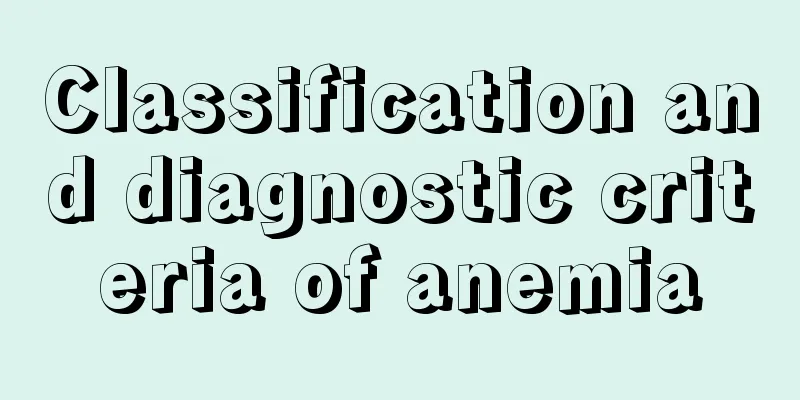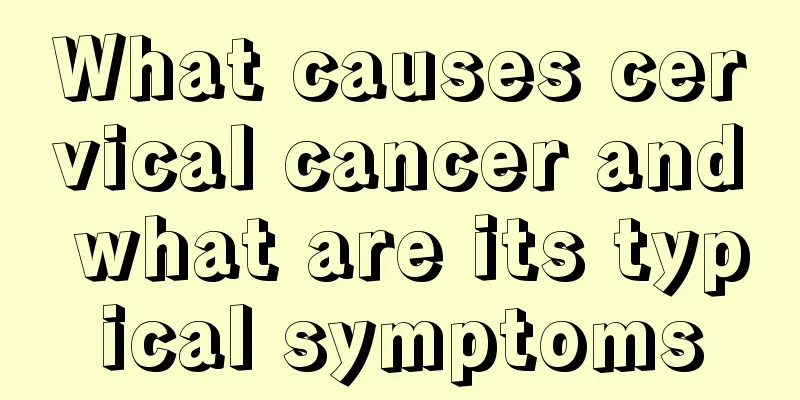Classification and diagnostic criteria of anemia

|
Anemia is a very common problem, especially for women, where it is more likely to occur. There are certain diagnostic criteria for whether anemia is mild or severe. According to these different criteria, anemia can be divided into different types. Different types of anemia require different methods of treatment and physical conditioning. Below we will introduce the diagnostic criteria and classification methods of anemia. 1. Diagnostic Criteria According to my country's standards, hemoglobin measurement values are: lower than 120g/L for adult males and lower than 110g/L for adult females, and their hematocrit values are lower than 0.42 and 0.37 respectively, which can be diagnosed as anemia. 2. Classification 1. Classification based on etiology and pathogenesis (1) Decreased red blood cell production ① Abnormal proliferation and differentiation of stem cells: Hematopoietic stem cells: aplastic anemia, Fanconi anemia. Erythroid progenitor cells: pure red cell aplasia, anemia caused by renal failure. ② Cell differentiation and maturation disorders: DNA synthesis disorders: Vitamin B12 deficiency, folate deficiency, defects in purine and pyrimidine metabolism (megaloblastic anemia). Hb synthesis defects: heme synthesis defects (iron deficiency anemia and sideroblastic anemia), globin synthesis defects (thalassemia). ③Unknown causes or multiple mechanisms: bone marrow infiltrative anemia, anemia of chronic disease. (2) Excessive destruction of red blood cells ① Endogenous: Red cell membrane abnormalities: hereditary spherocytosis, hereditary elliptocytosis. Erythrocyte enzyme abnormalities: glucose-6-phosphate dehydrogenase deficiency, pyruvate kinase deficiency. Abnormal globin synthesis: sickle cell anemia, other hemoglobinopathies. ②Exogenous: Mechanical: march hemoglobinuria, prosthetic heart valve hemolytic anemia, microangiopathic hemolytic anemia. Chemical, physical or microbiological factors: chemical poison and drug-induced hemolysis, extensive burns, infectious hemolysis. Immune: autoimmune hemolytic anemia, neonatal alloimmune hemolytic disease, drug-induced hemolytic anemia. Increased destruction of the monocyte-macrophage system: hypersplenism. (3) Hemorrhagic anemia: acute hemorrhagic anemia and chronic hemorrhagic anemia. 2. Classification based on cell morphology 3. Classification according to the degree of myeloproliferation (1) Proliferative anemia: such as hemolytic anemia, hemorrhagic anemia, megaloblastic anemia and iron deficiency anemia. (2) Hypoplastic anemia: such as aplastic anemia. 3. Treatment Methods In emergency situations, patients with severe anemia, the elderly, or anemia patients with cardiopulmonary insufficiency should receive red blood cell transfusions to correct anemia and improve the body's hypoxia. However, blood transfusion is only a temporary treatment measure. Repeated blood transfusions may lead to hemochromatosis, which requires iron removal treatment. Therefore, it is most important to find the cause and provide targeted treatment. Usually, anemia is just a symptom, not a single disease. Therefore, the underlying cause needs to be determined before effective treatment can be carried out. Patients with acute massive blood loss should actively stop bleeding, while quickly restoring blood volume and transfusing red blood cells to correct anemia. Nutritional anemia can be treated by supplementing the missing nutrients, such as iron supplementation for iron deficiency anemia and treatment of the primary disease that causes iron deficiency; and folic acid or vitamin B12 supplementation for megaloblastic anemia. The treatment of non-nutritional anemia is more complicated. Autoimmune hemolytic anemia is mainly treated with immunosuppressants such as glucocorticoids. Chronic aplastic anemia is mainly treated with cyclosporine combined with androgens. For example, inherited anemias such as Fanconi anemia can be treated with hematopoietic stem cell transplantation. |
<<: Can anemia cause splenomegaly?
>>: How to treat long-term diarrhea
Recommend
What should I pay attention to after having my wisdom teeth removed
If all the wisdom teeth grow out, there are four ...
Things to note after MRI
Magnetic resonance imaging is a relatively common...
What are the uses of sodium hydroxide
With the advancement of modern technology, many c...
What methods can be used to remove freckles at home
In life, there are many ways to remove freckles. ...
How to wash ink off clothes
Calligraphy is one of China's national treasu...
What are the symptoms of chronic colorectalitis
Chronic colitis and proctitis are relatively comm...
Question: How should I maintain my health after brain cancer surgery?
The best time to treat cancer is the early stage ...
What juice can cure constipation
In fact, many people are very worried about their...
Breathing in and rubbing your belly while taking a bath can regulate your stomach and relieve constipation
After a busy day, taking a hot bath can not only ...
How to recover a severed finger nerve
Many things in people's work and life need to...
The psychology of a child when being beaten
The main psychological reactions that children ma...
Are raisins acidic or alkaline? What are the benefits?
Raisins taste sweet and sour and are a very healt...
Things to note when treating gastric cancer
There are often some problems encountered during ...
How is right-sided intestinal cancer diagnosed?
Right colon cancer refers to colon cancer that oc...
How to prevent hamartoma in daily life
Due to the lack of understanding of hamartomas, m...









